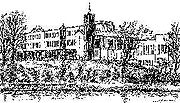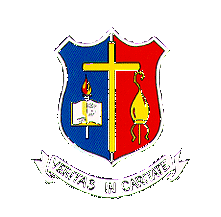
St. Munchin's College
Encyclopedia

Limerick
Limerick is the third largest city in the Republic of Ireland, and the principal city of County Limerick and Ireland's Mid-West Region. It is the fifth most populous city in all of Ireland. When taking the extra-municipal suburbs into account, Limerick is the third largest conurbation in the...
city suburb of Corbally in the Irish
Ireland
Ireland is an island to the northwest of continental Europe. It is the third-largest island in Europe and the twentieth-largest island on Earth...
county of Limerick
County Limerick
It is thought that humans had established themselves in the Lough Gur area of the county as early as 3000 BC, while megalithic remains found at Duntryleague date back further to 3500 BC...
. The school was founded in 1796.
College crest

History
"Limerick Diocesan College, under the Patronage of St. Munchin, was first founded by Most Rev. John Young, Bishop of Limerick, in 1796. After many changes, it is established on the site in Corbally by Most Rev. Henry Murphy, Bishop of Limerick, who placed the foundation stone on 28th April, 1960"Thus reads, in English translation, the inscription to be seen on the foundation stone of St. Munchin’s College, Corbally, Limerick. It is an institution of learning with a long and noble history, stretching back over two hundred years. In this time, St. Munchin’s College has indeed seen many changes, both of organisation and location.
The Diocese of Limerick was formally established at the Synod of Rathbreasil in the year 1111. The boundaries of the diocese as arranged at that time have remained practically unchanged to the present day. The diocese includes most of County Limerick, and two parishes in Co. Clare. The patron saint of the diocese is St Munchin; tradition holds that St. Munchin was the first bishop of Limerick and he founded a cathedral which remained the principal church of the diocese until Donal O'Brien, King of Limerick, built St. Mary’s Cathedral in the 12th century.
For many centuries Irish Theological Schools had been suppressed and the students for the priesthood had to be educated outside Ireland. Many famous Colleges for the education of priests were established on the continent-Lisbon, Salamanca, Paris and Rome to name just a few However, by the end of the 18th century, circumstances had changed. Firstly, the effects of the French Revolution had closed many of the seminaries abroad and secondly, the attitude of the government to the education of the Catholic clergy had changed. A bill to provide for the education of the Catholic clergy received the Royal Assent on June 5, 1795. The Duke of Leinster offered a site at Maynooth, his offer was accepted and, on October 1, 1795 St. Patrick's College at Maynooth was formally opened.
At this time, in most Irish dioceses, preparatory seminaries were established, among them St. Munchin’s College, Limerick. The driving force behind the establishment of the new college was Bishop John Young. On September 29, 1796, St. Munchin's College was opened at Palmerstown in Limerick City. The curriculum was made up of Logic and Divinity. It was a major seminary for those pursuing studies for the priesthood. It was some years before St. Munchin's took on the form of a Diocesan College, that is, an educational institution in which both laymen and future priests pursue their secondary studies together. The first of many changes in location was not long coming and, within six months, by March 1797, the College moved from Palmerstown to Newgate Lane where it would remain for only three years. The next site was at Peter's Cell and, by 1809, it was on the move again, this time to Park House in Corbally.
In 1825 the College at Park House closed but, its last President, opened an Academy in Mallow Street. The Academy was opened to lay students as well as students for the priesthood. A fully fledged St. Munchin's College was opened again in 1853, under the patronage of Bishop John Ryan. The College, known as 'St. Munchin's Diocesan Seminary' was located at No. 1 Hartstonge Street, and the College authorities were very proud of the facilities that were available:
"The seminary itself is situated in the most elevated and healthy part of the city, and no expense has been spared to fit it up in the best possible manner, for the reception of day pupils and boarders".
A wide range of subjects was on offer, including Music, Drawing, Painting, and Dancing. A major change in the running of St. Munchin's took place when Bishop Ryan decided to remove the diocesan clergy from the college. This, it would seem, was because "the priests of St. Munchin's had paid too much local attention to a local election". (Thomas Begley, Diocesan Historian)
Bishop Ryan approached the Society of Jesus with a request to take over the administration of the College. After formal negotiations were successfully concluded between the Bishop and the Society of Jesus, both in Ireland and in Rome, St Munchin's College became a Jesuit-run school on 10 March 1859. This wasn’t the first venture into education by the Jesuits in Limerick. In fact, their first school in Ireland was set up in St. Mary’s Parish in 1565.
By 1862 the Diocesan College moved to Crescent House where the curriculum included classical and modern languages, mathematics, physics, history, geography, and elocution. The school also had a 'Mercantile Department' in which 'an extensive and accurate knowledge is imparted of arithmetic, book-keeping, abstracts and other requirements of the actuary's office'. Young men were prepared there for 'the university and the ecclesiastical colleges, the learned professions, the public service, civil and military'.
In 1867 Bishop George Butler decided to re-establish his own seminary at Hartstonge Street and the Jesuits maintained their own school at the Crescent which was renamed the Crescent College
Crescent College
Crescent College Comprehensive SJ is a secondary school located on a section of 40 acres of parkland at Dooradoyle, Limerick, Ireland. The college is one of a number of Jesuit schools in Ireland.- History :...
. The two schools quickly developed a rivalry on the rugby field which survives to this day.
In the 1870s the Jesuits were again asked to administer St. Munchins, which this time moved to Mungret. This arrangement, however, was not to last and the College was again transferred to the clergy of the Diocese and moved to the former town house of Lord Limerick at Henry Street where it remained until a new school was built in the 1960s at Corbally.
Torch Magazine
Every year, transition year students in the school produce the end of year magazine called 'The Torch'. The magazine began in 1977 and has been produced every year since. The Torch features profiles of all the 6th year students (which are written by their fellow classmates), articles about everything that goes on in the school during the year, interviews with new teachers and students who deserve special recognition (such as captains of rugby teams) and photos from the school year. The Torch is regarded by many as one of the best student magazines in the Limerick area.Sport
The school has been relatively successful at rugby in recent times. Winning its first title in the Munster Schools Senior Cup in 1968, it has won since the Cup four times. It also has three titles at Junior Cup level. Many former pupils have gone on to play at international level, including Bill O'Connell, Bill Mulcahy, Larry Moloney, Colm Tucker (also a Lion), John Fitzgerald, Paul Hogan, Philip Danaher (also Irish captain), Anthony Foley (also Irish captain), Keith Wood (also a Lion and Irish captain) and current Irish internationals Marcus Horan, Jerry Flannery, Barry Murphy, Jeremy Staunton and Keith EarlsAlumni
- Keith WoodKeith WoodKeith Gerard Mallinson Wood and educated at St Munchin's College, Limerick is a former international rugby union footballer who played hooker for Ireland, the Lions, Garryowen, Harlequins and Munster....
, former rugby player for Munster, Ireland and the British and Irish Lions. Winner of IRB International Player of the YearIRB International Player of the YearIRB Player of the Year is an accolade awarded annually by the International Rugby Board. It is awarded to the player who is adjudged to have been the best performer in rugby union internationals in the preceding season IRB Player of the Year is an accolade awarded annually by the International...
in 2001.
- Richard V. Hourigan, former Senator
- Niall FitzGeraldNiall FitzGeraldNiall FitzGerald, KBE is an Irish businessman. FitzGerald grew up in Limerick, Ireland and was educated at St Munchin's College in Limerick. He graduated with a degree in Commerce from University College Dublin...
KBE (1963), former Chairman and CEO of UnileverUnileverUnilever is a British-Dutch multinational corporation that owns many of the world's consumer product brands in foods, beverages, cleaning agents and personal care products....
plc until his appointment as Chairman of ReutersReutersReuters is a news agency headquartered in New York City. Until 2008 the Reuters news agency formed part of a British independent company, Reuters Group plc, which was also a provider of financial market data...
in 2004;
- Eamon CaseyEamon CaseyEamon Casey is Roman Catholic Bishop Emeritus of Galway and Kilmacduagh, Ireland.-Priest and bishop:...
, former Bishop of Galway http://www.timesonline.co.uk/tol/news/world/ireland/article745495.ece
- Jeffrey Casey (1992), Gay rights activist .
- Enda Connellan (1965), CEO Dublin Port Company http://www.dublinport.ie/ ;
- John GormleyJohn GormleyJohn Gormley is an Irish politician. He was the leader of the Irish Green Party from 2007 to 2011, and was a Teachta Dála for the Dublin South East constituency from 1997 to 2011. He served as Minister for the Environment, Heritage and Local Government from 2007–11...
(1977), leader of the Green Party (Ireland)Green Party (Ireland)The Green Party is a green political party in Ireland. It was founded as the Ecology Party of Ireland in 1981 by Dublin teacher Christopher Fettes. The party became the Green Alliance in 1983 and in 1987 was renamed to its current title in English...
was appointed Minister for the Environment, Heritage and Local Government in the Irish Government of 2007;
- John Fleming (1965), appointed Catholic Bishop of KillalaKillalaKillala is a village in County Mayo in Ireland, north of Ballina. The railway line from Dublin to Ballina once extended to Killala. To the west of Killala is a Townsplots West , which contains numerous ancient forts.- History :...
Diocese, Co. Mayo, Ireland in 2002.
- Fergal Lawlor (1991), drummer of The Crannberries
- John Feely (1965), Professor of Pharmacology and Therapeutics, Trinity College Dublin.
- Keith EarlsKeith EarlsKeith Earls is an Irish rugby union footballer for Munster in the RaboDirect Pro12 and Heineken Cup. Internationally, Earls plays for Ireland, and he represented the British and Irish Lions on their 2009 tour to South Africa. He plays as an Outside Centre, Winger or Fullback. He won a Munster...
,Munster,Ireland and British and Irish Lions Present
- Kevin Kiely , (2004) Stage and Film Actor.
External links
- http://www.stmunchinscollege.com/
- http://www.nsopw.gov/Core/Portal.aspx

